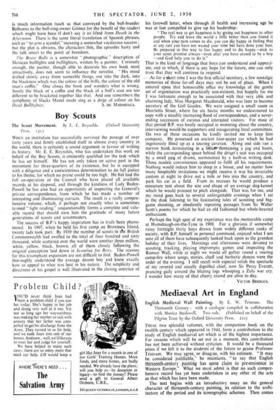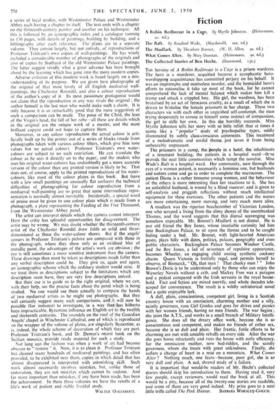Mediaeval Art in England
English Medieval Wall Painting. By E. W. Tristram. The Thirteenth Century : with a catalogue compiled in collaboration with Monica Bardswell. Two vols. (Published on behalf of the Pilgrim Trust by the Oxford University Press. £21)
THESE two splendid volumes, with the companion book on the twelfth century which appeared in 1944, form a contribution to the study of English mediaeval art which is of the highest importance. For reasons which will be set out in a moment, this contribution has not been achieved without criticism. It would be a thousand pities if we left it to the students of the future to praise Professor Tristram. We may agree, or disagree, with his estimate. " It may be considered justifiable," he maintains, " to say that English thirteenth-century paintitig has s9me claim to pre-eminence in
Western Europe." What we must admit is that no such compre- hensive record has yet been undertaken in any other of the arts as that which has here been made.
The text begins with an introductory essay on the general character of thirteenth-century painting, its relation to the archi- tecture of the period and its iconographic schemes. Then comes
a series of local studies, with Westminster Palace and Westminster Abbey each having a chapter to itself The text ends with a chapter on the thirteenth-century painter and another on his technique. All this is followed by an iconographic index and a catalogue running to 130 pages, with details of paintings, building by building, and a bibliography after each reference. The plates are in a separate volume. They consist largely, but not entirely, of reproductions of Professor Tristram's own copies of wall-paintings. He has wisely included a considerable number of photographs of the originals and also of copies by Stothard of the old Westminster Palace paintings. The latter suggest vividly what a great advance has been brought about by the learning which has gone into the more modern copies.
Adverse criticism of this modern work is based largely on a mis- understanding of its purpose. We are given here photographs of the original of that most lovely of all English mediaeval wall- paintings, the Chichester Roundel, and also a colour reproduction of the author's copy of it. Its most passionate protagonist would not claim that the reproduction in any way rivals the original ; the author himself is the last man who would make such a claim. It is only because it is so remarkably good that the mere suggestion of such a comparison can be made. The poise of the Child, the lean of the Virgin's head, the fall of her robe—all these are details which in the original are the unique work of a master, and the most brilliant copyist could not hope to capture them.
Moreover, in any colour reproduction the actual colour is arti: ficially built up by the printer out of a series of blocks (made from photographs taken with various colour filters, which give him tone values but no actual colour). Professor Tristram's own water- colours are subject to no such restriction. He can translate the colour as he sees it directly on to the paper, and the student who uses his original water-colours has undoubtedly got a more accurate version of the colour than any printed version is likely to be. That does not, of course, apply to the printed reproductions of his water- colours, like most of the colour plates in this book. But (save with a few small paintings on unusually flat surfaces) the technical difficulties of photographing for colour reproduction from a mediaeval wall-painting are so great that some intermediate repre- sentation is normally almost inevitable. Incidentally, a special word of praise must be given to one colour plate which is made from a photograph, a plate representing the Feeding of the Five Thousand, from the Westminster Abbey panel.
The artist can interpret details which the camera cannot interpret. Here the critic has splendid opportunities for disagreement. The artist may be wrong. We may doubt whether the thirteenth-century artist of the Chichester Roundel drew folds so solid and three- dimensional as those the water-colour shows. But if the angels' censers in Professor Tristram's picture are compared with those in the photograph, where they show only as an oxidised blur of metallic paint, the advantages of the artist's work are obvious ; the eye is still sometimes a more sensitive instrument than the camera. These drawings then must be taken as descriptions much fuller than any verbal description could be. They give us, again and again, an iconographic scheme which the ordinary student would miss. If we treat them as descriptions subject to the limitations which any description must have, they are very fine descriptions indeed.
But their use is to guide us to the right original, where we can, with their help, see the precise facts about the point which is being studied. No one would use them actually to compare the hands of two mediaeval artists as he might use photographs. But they will certainly suggest many such comparisons, and it will now be possible (for instance) to investigate, in a way that has hitherto been impracticable, Byzantine influence on English art in the twelfth and thirteenth centuries. The roundels on the roof of the Guardian Angels' chapel in Winchester Cathedral, one of which is reproduced on the wrapper of the volume of plates, are singularly Byzantine, as is, indeed, the whole scheme of decoration of which they are part. Professor Tristram's book, and Dr. Demus's recent book on the Sicilian mosaics, provide ready material for such a study.
Not long ago the fashion was when a work of art had become obscure to " restore " it. Now, it is to clean it. Professor Tristram has cleaned many hundreds of mediaeval paintings, and has often provided, to be exhibited near them, copies in which detail that has almost disappeared is interpreted with astonishing skill. Such work almost necessarily involves mistakes, but, unlike those of restoration, they are not mistakes which cannot be undone. And far more important than mistakes, if any have been made, has been the achievement. In these three volumes we have the results of a life's work of patient and richly fruitful study.
WALTER OAKESHOTT.



































 Previous page
Previous page